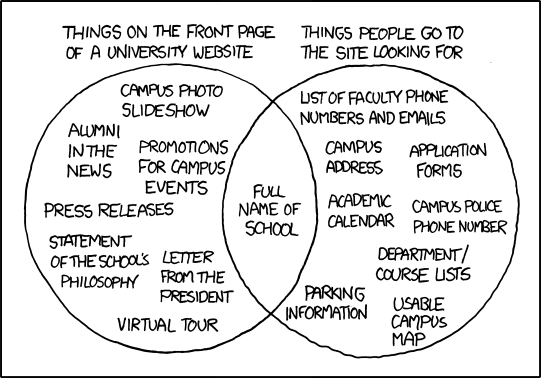Digital transformation and the startup playbook
This is the first of a series of reflections on this year’s Institutional Web Management Workshop. Read an introductory post.
Why we need to transform the way we do digital
On day one of IWMW we were treated to an inspiring talk by Paul Boag from the digital agency Headscape. At the University of St Andrews we have recently had the pleasure of working with him for a day, so a lot of what he had to say was familiar. Some of the examples he used were pretty close to home as well.
Paul says that institutions should engage in a programme digital transformation. He notes that this wording is carefully chosen.
It is digital because it encompasses the web, social media, e-learning and beyond. Everything needs to be coordinated.
The word transformation emphasises that it is not about creating another service department, as many web teams have traditionally been. No longer should work be driven by who shouts the loudest. The programme should have its own agenda, and those working on it should be the ones to drive its direction.
Changing the institution

Moreover, the programme is not permanent. It is not about creating a team that will exist forever. It is a programme of work aimed at changing the institution. Once that mission is complete the team will disband.
This is not about creating another silo. It is a team to help put digital in the hands of everyone across the organisation.
For me, the key quote in Paul’s talk was: “If we do nothing we don’t stand still; we get swept back.”
Certain universities appear to have a temptation to smugly rely on their past reputations for their future business. Other industries got caught out while resting on their laurels. As a sector we need to avoid being like the music industry or journalism. We need to avoid being like Kodak.
Using the startup playbook
There were plenty of parallels in a following talk by Ross Ferguson, head of the digital marketing and communications team at the University of Bath. His talk was about rebooting a big university website by using the startup playbook.
Ross moved to the University of Bath from the Government Digital Service. So he has a lot of experience changing organisations to make them more focussed on digital.
As Gov.uk moved from alpha to beta to live, the Government Digital Service progressed from just getting the government to rethink its website. It is now changing the way the government and the civil service runs itself.
Ross asked himself if it would be possible to achieve the same at a university. He felt “meh” about most university websites. Similar information architectures, mostly much of a muchness, all following similar models, all focused on selling and marketing.
Let’s face it. The Xkcd comic is true, and deep down we all know it.
Using a radical approach
Ross decided to implement a radical approach based not on any project management methodology, but on six simple principles:
- Put user needs first.
- Make decisions based on data.
- Release iteratively and often.
- Keep things simple and consistent.
- Provide ongoing support.
- Work in the open.
The team takes inspiration from an agile approach, but does not follow a textbook version of scrum. Instead they take what works for them.
With what they deliver, the idea is to focus on producing the minimum viable product, get it in the hands of the users as soon as possible, then iterate and build on it over time. It is like Spotify’s approach to building a product.
There was one particularly refreshing moment of Ross’s talk where he said: “I won’t do gantt charts; I won’t do a project plan; I won’t do a risk register. I won’t ask my team to do it. If you don’t like that, get a new head of digital.”
This all chimes with my own view that running a digital service should not be considered a project, with the usual box ticking for the sake of box ticking that comes with it. Instead, it is about building the right processes that work for your situation, developing a fully open and collaborative culture, and bringing good people in to do a good job.
We are often expected to follow a textbook version of how things should be done. But digital and technology evolves so quickly that the textbook is out of date by the time it has been published.
It was refreshing to be able to take inspiration from a successful team that is questioning established processes and taking a radical approach towards digital change.
I’ve said it before, I’ll say it again – Bath Uni are light years ahead of pretty much every other uni in the UK! #iwmw14
— Milly Shaw (@millyshaw) July 17, 2014
A temporary team to enable change
Ross said that his ultimate aim is for there to be no central digital team as such. The approach should be devolved in the end once these processes are embedded throughout the institution.
This was perhaps the strongest of many parallels with Paul Boag’s talk. Paul emphasised that once digital transformation has taken place within an institution, the digital transformation team should disband.
In both cases, the role of the central digital team is to enact institution-wide change, aimed at equipping it to properly manage digital in the long term.
